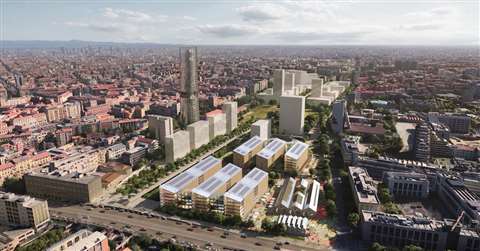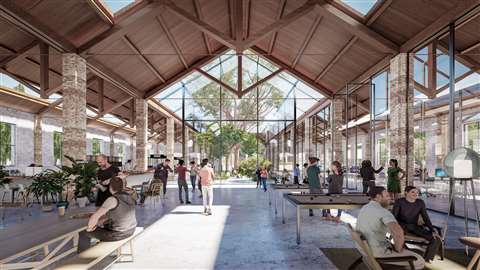Milan rail yard to become 2026 Olympic Village
20 July 2021
SOM architects win competition to design site with sustainability and future use at its heart
 An aerial impression of the proposed Porta Romana Olympic Village in Milan
An aerial impression of the proposed Porta Romana Olympic Village in Milan
Architect Skidmore, Owings & Merrill (SOM) has won a competition to design the village for athletes taking part in the 2026 Milan-Cortina Winter Olympics.
The Porta Romana Olympic Village will be developed by COIMA SGR and its partners on the site of the current Porta Romana railway yard in Milan.
The Olympic Village, comprising six new residential buildings and two renovated and transformed historic structures, will form part of a larger project – Parco Romana – set to include eco-zones and a suspended forest.
Of the 27 international groups competing for the Olympics contract, SOM were judged to have best satisfied the committee’s stated aim of looking beyond the 2026 event to create a sustainable urban community for the future.
SOM’s design partner Colin Koop said, “Rather than ceasing to be of use after the Olympics, the Porta Romana Olympic Village will ultimately become a vibrant, self-sustaining neighbourhood built around the principles of social equity, environmental commitment, wellness and inclusivity.”
The village will be a nearly zero energy building (NZEB), with features including passive cooling strategies, solar panels, and rooftop gardens, allowing 30% of its required energy to be produced on site. Additionally, more than 50% of the site’s drinking water will be drawn from stormwater. A reduction of some 40% of CO2 is also anticipated in terms of the heating and cooling of the buildings.
 An impression of the interior of the proposed Olympic Village in Milan
An impression of the interior of the proposed Olympic Village in Milan
The structure of the six new residential buildings of the village will be timber, while façades will be manufactured from low-embodied carbon materials.
Within the development project, two historic structures will be renovated and space will be created for food production on urban farms.
Following the Olympic games, the athletes’ living areas will become student accommodation, while the former railway side building will be used for affordable housing.
Manfredi Catella, COIMA founder & CEO, said, “The 2026 Olympic Village will represent a new urban laboratory for Milan, the first to be designed and built in its future configuration with spaces, functions, and materials already designed for their conversion, meeting NZEB principles.”
Adding that the integrated district would be managed through an evolutionary digital platform, Catella said, “The project represents our commitment to ESG [environmental & social governance] through COIMA ESG City Impact, the first Italian closed-end investment fund with measurable objectives for the country’s sustainable regeneration, which will retain the Olympic district in its portfolio following its conversion into a student residence.”
STAY CONNECTED



Receive the information you need when you need it through our world-leading magazines, newsletters and daily briefings.
CONNECT WITH THE TEAM












